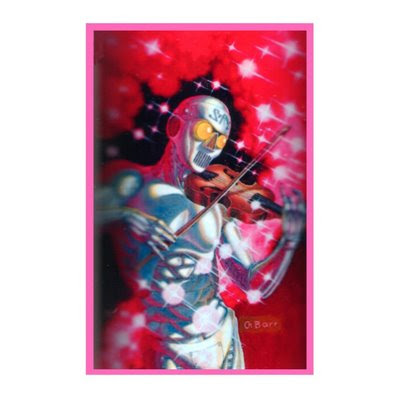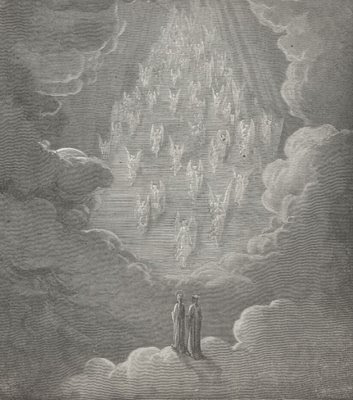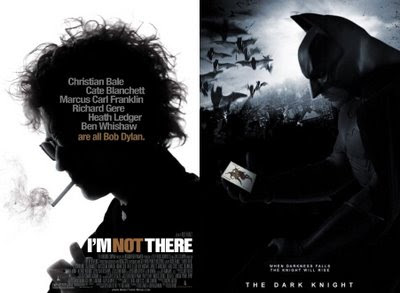
What if two films that were very dissimilar in content and context were otherwise related enough that we could think of one as a sequel to the other? More than ever before, multiplex cinemas are packed with sequels of a more traditional sort, in which most of the characters from the original film return and a similar conflict takes place in the same fictional universe. When sequels are released, such fictional universes become franchises, and franchises don’t interbreed – but could a sequel to one film come from an entirely separate franchise, in this case that of the Batman universe? Even more radically, could a film like I’m Not There, which is about the life of Bob Dylan, a real person, have a decidedly fictional sequel which takes its material from something like the illustrious Batman mythology?
Now I’m not, of course, implying that there is some shadowy circle of film producers who engineered a ‘secret sequel’ to I’m Not There – after all, The Dark Knight was already a sequel to Batman Begins in the more traditional sense. But we needn’t seriously ‘believe’ that the two are related in order to derive an interesting sort of appreciation from the comparison. In fact this is more than a simple comparison – films are similar, even weirdly so, all the time – but the many parallels between I’m Not There and The Dark Knight don’t just run surprisingly deep, the fact that they do is in itself appropriate to the themes that can be read in each film. Because taken together, these two films show us that reality and fictionalisation are not simple opposing absolutes – each film exemplifies the other in revealing an alternative way of thinking about myths and legends and how they relate to the biased stories we construct about the so-called ‘Real World’.

Dramatis Personae
I’m Not There, released November 2007, directed and co-written by Todd Haynes (Velvet Goldmine, Far From Heaven), is to my mind easily the most interesting, perhaps the best, pick of the oddly large bunch of biopics on musical heroes that we’ve seen in the last decade. This is because I’m Not There is an anti-biopic. At the film’s opening, a caption informs us that what we’re about to watch is ‘inspired by the many lives of Bob Dylan’, and throughout, the film vigorously undermines the notion that there is one single, truthful story to be told about the life of a musical legend, or that such figures even have a single coherent identity (welcome relief from the borderline pornographic myth-indulging of films like Control). Just as one Robert Zimmerman renamed himself Bob Dylan, there is, in turn, no character in I’m Not There named ‘Bob Dylan’. Instead there are six characters that resemble aspects of the real Dylan and his life, and yet each is plainly radically fictional. One Dylan is black, another is played by a woman and photographed in black and white, another stares straight into the camera from in front of a pure white backdrop, another (based on Dylan’s appearance in the similarly equivocal film Pat Garrett and Billy the Kid) appears to be the historical outlaw Billy the Kid and another is shown as an actor who played a Dylan-like figure in a biopic film-within-the-film. It’s difficult to imagine a film more self-aware, more richly deconstructive about the task of turning the story of a legendary figure into a film.

Each of these six characters is a persona that both points to the ‘real’ Dylan and yet simultaneously points in a very different direction, and each comes with a different setting and cinematic language. To add to the confusion, the story of each is weaved together as the film progresses. Marcus Carl Franklin plays a poor, wayward hobo child impersonating (and only referred to as) Woody Guthrie. Ben Whishaw plays a Dylanesque character who similarly gives his name as ‘Arthur Rimbaud’ and addresses a courtroom with various poetic epigrams and mots justes, functioning as a sort of narrator for the film. Christian Bale plays Jack Rollins, resembling the early Dylan, who wrote heroic political folk songs before becoming disillusioned and ending up a born again Christian pastor. Heath Ledger plays the misogynistic Robbie Clark, an actor who portrays Jack Rollins in the film ‘Grain of Sand’ and whose defective love life and sad divorce echoes parts of Dylan’s own history. Cate Blanchett plays Jude Quinn, an exhausted, sardonic hipster who quarrels with music critics, angers his original folk fans by going electric (in a play on his name, they call him ‘Judas’) and apparently dies in a motorbike accident. In the most overtly metaphorical segments of the film, Richard Gere plays a historical Billy the Kidd living with his dog on the outskirts of the appropriately-named village of Riddle, where apocalyptic fear over the impending destruction of the village to build a highway has coincided with a Bosch-like Halloween masquerade, encouraging Billy to stand up to Pat Garrett (the lawman who ultimately killed the outlaw) at a public meeting. Of course the real Dylan, as the film’s title (referring to one of Dylan’s songs) suggests, is ‘not there’ – in fact at the start of the film the title appears on screen as the culmination of randomly appearing and disappearing words and letters: ‘I’m not he’, ‘I’m (not) her’, ‘I’m not here’, ‘I’m not there’ (a similar word game is played in The Dark Knight: the Joker’s truck has ‘laughter’ written on the side, at the start of which sprayed an ugly S has been sprayed).
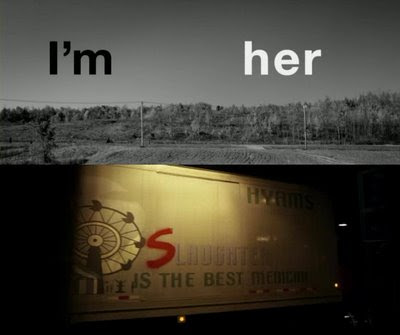
A year later, Christian Bale and Heath Ledger were back for The Dark Knight, portraying the legend of Batman’s struggle with his nemeses, the Joker and Two-Face. Since he first appeared in 1939, Batman has, like Dylan in I’m Not There, been played by many different actors, and the setting and tone of his adventures has varied wildly throughout his history, from the decidedly camp (in the sixties TV series and the feature films before Batman Begins) to the horrendously sinister (in Arkham Asylum: a Serious House on Serious Earth). Rather than Dylan, this time the position of pop culture legend protagonist is occupied by the Batman, a character who has always been not just fictional but rather blatantly fantastical, despite the increased realism of the more recent films. Just as in I’m Not There, Bale returns as the heroic do-gooder who nevertheless battles doubts and demons, while Ledger returns as the villain, the dark reflection, the opportunist, the pretender, the ‘player’ (actors and clowns are historically not so different), again, bitter about his messed-up family life. Batman also recalls the masked fantasy vigilante Billy the Kid of I’m Not There, while the Joker also echoes that film’s anarchically nihilist dandy Jude Quinn, and both these characters resonate too with the amoral, destructive sides of Batman and Dylan respectively.
Quinn and the Joker are both anarchically nihilistic, both enjoy spouting pearls of ‘wisdom’, both are powerful, influential and provocative artists who court the news and have an entourage of collaborators and both are pale-faced dandies with crazy hair. When explaining himself, Quinn says ‘I refuse to be disassociated from the evils of the world’, and ‘[Pain, remorse, love]… I have none of those feelings’, and believes that ‘traditional music… is so full of mystery and contradictions and chaos… its meaninglessness is holy’ (and as a voice-over to a Quinn segment, ‘Arthur Rimbaud’ observes ‘I accept chaos, I’m not sure whether it accepts me’), all of which recalls much of what the Joker says, most prominently perhaps ‘I’m an agent of chaos’. When the Joker burns an enormous pile of cash, echoing Quinn’s protesting to his manager that he doesn’t want to be a millionaire, he claims ‘it’s not about money, it’s about sending a message: everything burns’, exactly the sort of thing Quinn would say, if he were just that little bit more nihilistic. Quinn represents Dylan’s dark and troubled side, and in The Dark Knight, Quinn returns symbolically as the Joker, a monster wholly given over to evil who himself suggests the dark side of Batman (the two are repeatedly likened throughout the film, particularly when Batman’s roaring interrogation sounds ominously reminiscent of the Joker’s own).
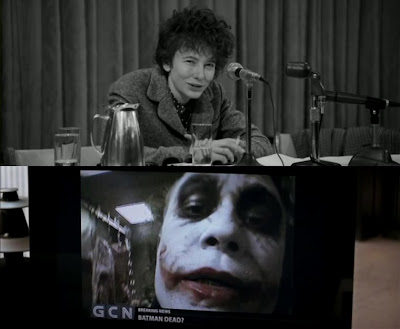
Ultimately the interconnected figures of Batman, the Joker, Two-Face, all of I’m Not There’s Dylans and Bob Dylan himself, all being mysterious players who use aliases and wear masks of sorts, together form a web of internal and mutual contradictions made up of symbolic personae.
Will the real Batman please stand up?
So The Dark Knight would be a sequel to I’m Not There on the grounds their similar character structures and themes rather than (for the most part) the particulars of content. A prominent narrative device that both films have in common is the depiction of multiple and irreconcilable manifestations or personae related to the same character. In I’m Not There, this aspect is an unconventional story-telling technique that undermines the overall coherency of the film (and by extension that of Dylan’s life) but in The Dark Knight it’s smoothly coalesced and integrated into the film’s comparatively far more coherent fictional universe in which secret identities are a defining characteristic.
Near the beginning of The Dark Knight an action sequence in a car park becomes disorientating when there appear to be multiple Batmen working as a team to fight the Scarecrow and assorted mobsters. It being the first appearance of the Batman silhouette in the film, we’re likely to believe that it’s the man himself before we’re shown that there’s more of them. Unlike the familiar Batman, these Batmen have low-grade costumes and are using machine guns. The real Batman soon shows up and battles both the hoodlums and the ‘Batmen’, until it turns out that these Batman-looking guys are copycat vigilantes, a law unto themselves. Later in the film the Joker, intent on drawing out and killing Batman, tortures and murders one of these copycat Batmen and hangs his body outside Gotham City’s mayor’s office, with a message attached: ‘Will the real Batman please stand up?’.
 These multiple versions of Batman, though they don’t challenge the veracity of the ‘real’ Batman, recall the multiple versions of Dylan, and I’m Not There’s viewers could well be asking ‘will the real Bob Dylan please stand up?’. In parallel with this is the apparent plurality of the Joker’s own identity. In the simplest sense, there are multiple Jokers at the start of The Dark Knight during the bank robbery – all of the Joker’s gang wear clown masks and beneath one of these masks the Joker himself is anonymously hiding, unbeknownst to his minions. But viewers will also have noticed that the Joker tells radically different, conflicting stories about his own life, or ‘how he got these scars’, throughout the film, which is starkly reminiscent of I’m Not There’s radically different biographies of Dylan. We’re likely to conclude, while the Joker explains his scars the second time around, that he’s at least partly a liar, just as we note the blatant fictionality of all I’m Not There’s Dylans. In this light the Joker’s stories can be seen as warped jokes – anti-jokes or post-jokes – because like jokes they’re ‘untrue’ little tales complete with punch-lines, though in this case traumatic and tragic (‘Why so serious?… let’s put a smile on that face’ and ‘She couldn’t stand the sight of me!… Now I see the funny side, now I’m always smiling’) rather than comic. In the Batman comics and graphic novels the Joker’s origin is similarly unclear, with various different accounts having been offered across the years. Bruce Wayne’s (he’s, uh, secretly Batman by the way) butler Alfred sums up the resistance of the Joker (and Dylan as well) to conventional biographical and psychological assessment when he suggests to Wayne, ‘perhaps this is a man that you don’t fully understand’.
These multiple versions of Batman, though they don’t challenge the veracity of the ‘real’ Batman, recall the multiple versions of Dylan, and I’m Not There’s viewers could well be asking ‘will the real Bob Dylan please stand up?’. In parallel with this is the apparent plurality of the Joker’s own identity. In the simplest sense, there are multiple Jokers at the start of The Dark Knight during the bank robbery – all of the Joker’s gang wear clown masks and beneath one of these masks the Joker himself is anonymously hiding, unbeknownst to his minions. But viewers will also have noticed that the Joker tells radically different, conflicting stories about his own life, or ‘how he got these scars’, throughout the film, which is starkly reminiscent of I’m Not There’s radically different biographies of Dylan. We’re likely to conclude, while the Joker explains his scars the second time around, that he’s at least partly a liar, just as we note the blatant fictionality of all I’m Not There’s Dylans. In this light the Joker’s stories can be seen as warped jokes – anti-jokes or post-jokes – because like jokes they’re ‘untrue’ little tales complete with punch-lines, though in this case traumatic and tragic (‘Why so serious?… let’s put a smile on that face’ and ‘She couldn’t stand the sight of me!… Now I see the funny side, now I’m always smiling’) rather than comic. In the Batman comics and graphic novels the Joker’s origin is similarly unclear, with various different accounts having been offered across the years. Bruce Wayne’s (he’s, uh, secretly Batman by the way) butler Alfred sums up the resistance of the Joker (and Dylan as well) to conventional biographical and psychological assessment when he suggests to Wayne, ‘perhaps this is a man that you don’t fully understand’. (Later on, the Joker is caught using a technology that turns a cellphone into a sonar-based imaging device, and Batman assembles the phones’ multiple different viewpoints to get a complete picture of Gotham with which to locate the Joker, but ultimately this technology is destroyed for being unethical – all of which parallels the multiple viewpoints I’m Not There uses in trying and locate Dylan.)
Gotham needs a hero with a face
Indeed, the Joker is one of Batman’s most mysterious foes. In the films at least, every other Batman villain has a ‘real’ name, identity and an onscreen origin story. Even after being searched and interrogated at the police station, the Joker’s true identity remains a mystery (‘Nothing. No matches on prints, DNA, dental. Clothing is custom, no labels. Nothing in his pockets but knives and lint. No name, no other alias’). He is nothing but an alias, a mask (Dylan played a character called ‘Alias’ in Pat Garrett and Billy the Kid). In fact, if the origin stories that the Joker offers in The Dark Knight and those of the comics have any grain of ‘truth’ in them, we’re led to believe that the man behind the mask is merely a down-on-his-luck average Joe with very little money or status (the opposite of Bruce Wayne) turned suddenly or slowly insane by traumatic events.
In both films the motif of masks, disguises and obscured or problematic identities is a development on the theme of plural identity. Two-face is emblematic of this – his very appearance, one side of his face stripped away and horribly disfigured, being a metaphor for multiple identities. Fantasy heroes and villains traditionally wear masks, and the costumed identity of the Scarecrow (a Batman supervillain who appeared in Batman Begins and appears briefly in The Dark Knight) is nothing but a disturbing mask made from sack-cloth, which is ripped off by Batman once he is caught to reveal a guilty grin. Another fantasy world of masks and costumes, heroes and villains, is that of Richard Gere’s Billy the Kid in I’m Not There.
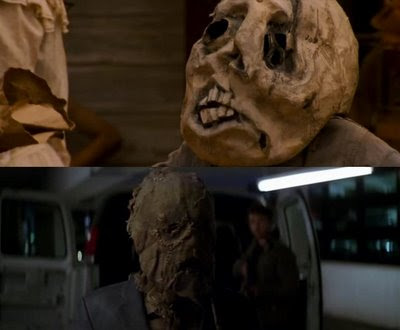
This narrative thread culminates in a confrontation between Billy and Pat Garrett at a tense town meeting about the imminent destruction of Riddle. Aware that Pat Garrett is his enemy, the heroic Billy righteously questions him while wearing a partially transparent mask. Suspicious, Garrett asks Billy to remove the mask, culminating in his arrest. Later, Billy escapes from prison and hitches a ride out of town on a freight train.

This scene and its context closely mirrors a sequence in The Dark Knight – after the Joker’s murder of a copycat Batman and his videotaped ultimatum (‘You want order in Gotham? Batman must take off his mask and turn himself in’) Gotham City is gripped by panic and a press conference is called so that the real Batman can reveal himself and turn himself in. At the meeting Gotham’s District Attorney Harvey Dent attempts to calm the terrified townsfolk, and then protects the real Batman (i.e. Bruce Wayne) by claiming that he’s the Batman, and so is escorted away by the cops. Prior to this, Bruce Wayne had said of Dent ‘Harvey is that hero. He locked up half of the city's criminals, and he did it without wearing a mask. Gotham needs a hero with a face.’ Both this scene and the one in I’m Not There take place at highly charged town meetings lead by authority lawmen and attended by a crowd of panicked citizens, and end with the hero heroically unmasked and arrested by the authorities – in both cases however, under that mask is just another alias, and the plans of the authorities ultimately fail.

Face-paint has the same effect as a mask of course, and the Joker’s messily daubed visage was one of the most iconic aspects of The Dark Knight’s visual design, departing as it did dramatically from the almost fussily neat foppery of previous Jokers. Amateur face-painting was also a major aspect of the visual landscape in the Billy the Kid segments of I’m Not There, as Riddle’s citizens seem to be holding some sort of absurd, apocalyptic Halloween carnival in view of the impending destruction of their town.

A young black man’s face is painted with something resembling the flag of the United States, while an elderly white man wearing a wig appears in blackface, both are symbolic transformations that recall the film’s black Dylan known as Woody Guthrie. Strangely, we also see two white men appearing in what I suppose must be ‘whiteface’, one of whom is Jim James from the rock band My Morning Jacket, singing Dylan’s song ‘Goin’ to Acapulco’. The other is an apparently savage young man, clutching a spear and peering at our hero Billy the Kid from deep inside the foliage around his house – not just a sinister interloper wearing white face-paint but with crude eye shadow too, this figure could be seen as an embryonic Joker biding his time, a hint of what was to come in the ‘sequel’.
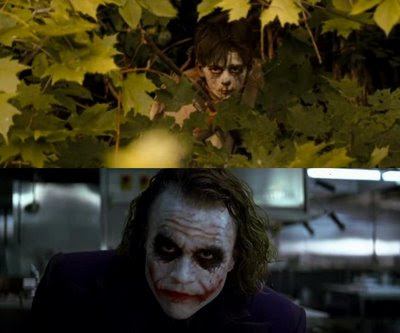
The white of ‘whiteface’ could represent death or purity (ironically or otherwise), but it also says something about the perception of identity. As a white person, wearing whiteface would be a post-racist demonstration that even when the race expressed by the face-paint is one’s own, such a symbolic representation is a crude, simplistic and insufficient to describe identity – we notice the unnatural extremity of the pure white paint in contrast to the more natural skin tone of the rest of the body, and so the colour face-paint as representation of identity is deconstructed and undermined.
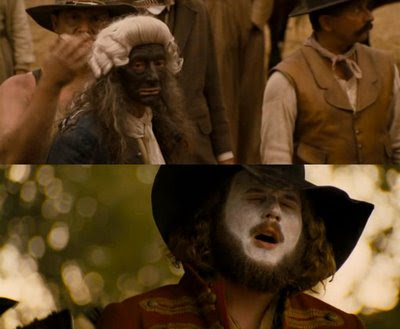
Indeed, the Joker’s shoddily applied white face-paint is all the more troubling for its hinting, in the places washed clean by sweat and violence, at the inevitable human ‘reality’ that necessarily lies beneath, of which we know nothing. This effect reaches its height when he removes the paint in order to pose as a cop, briefly appearing to us a smart, handsome (but nonetheless tragically scarred) blue-colour worker – and remaining in this instance silent, because this particular ‘real(er) life’ version of the unmasked Joker doesn’t belong to the symbolic world but wholly to the ‘real’ world. Similarly, in I’m Not There, even though he appears on concert footage playing the harmonica in the final shot of the film, the ‘real’ Dylan remains silent, as he, like the Joker, is a figure that lies beyond the reach of words, meanings and stories.

Gender, being in many cases a primary component of identity, is used to contradictory effect in both I’m Not There and The Dark Knight. Todd Haynes’s films all very much reward the reading perspective of queer theory (which argues that gender is constructed rather than inherent), what with identity, sexuality and the relationship between the two being recurring themes. Though it isn’t referred to in her/his narrative, Jude Quinn is played by a woman (Cate Blanchett, overall a very convincing Dylan) posing and dressing as a man, and in one instance wearing a moustache, that index of masculinity, that practically clichéd gesture of disguise. Conversely in The Dark Knight, the Joker (i.e. Quinn’s analogue), whose long hair and red lipstick are already rather feminine, disguises himself as a female nurse in order to infiltrate Gotham General Hospital (and for fun, perhaps).
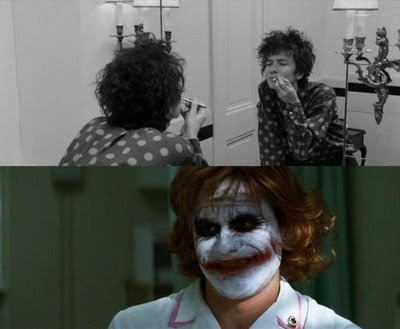
Other, smaller details underline the theme of cross-dressing: in I’m Not There Billy the Kid’s dog is referred to as female (‘c’mon, girl!’), even though it’s named Henry; in The Dark Knight, when Harvey Dent corners one of the Joker’s male stooges and demands to know his identity he gets no answer, discovering only the name-badge for a ‘Rachel Dawes’ (which is the name of Dent’s girlfriend, Maggie Gyllenhaal’s character).
Crusader or Menace?
Near the beginning of The Dark Knight, a special news report is playing on TV entitled ‘Batman: Crusader or Menace?’. Though we’re most likely to believe that Batman is more of a crusader than a menace, the question is pertinent. In many ways Batman could be either – in the minutes before, we’d seen him attack the well-meaning copycat vigilantes and blow up several parked cars just to intimidate the bad guys. As both Batman’s polar opposite and his inverted reflection, the Joker is both a crusader and menace too, but in turn is more of a menace in a conventional reading of the film. Though he tortures, murders and terrorises, the Joker seems to want to teach the world some lessons in the process. Every one of the Dylans in I’m Not There is both a crusader and a menace – Woody Guthrie is a fugitive, escaped from juvey, who preaches a blues gospel, Arthur Rimbaud teaches wisdom in a courtroom, Jude Quinn preaches nihilism and fights the establishment but infuriates a load of people in the process, Jack Rollins writes political folk-songs but makes a nuisance of himself when accepting a civil rights award and compares himself to Lee Harvey Oswald, Robbie Clark passionately plays Jack Rollins but is nevertheless a misogynist with wandering hands and Billy the Kid heroically stands up for Riddle whilst, well, being Billy the Kid.
 Of all the Dylans, it’s Jude Quinn who’s the biggest menace. He throws up in the laps of his friends, stalks women, taunts his audience and is appallingly rude, and he’s hated by his former fans for going electric and turning away from political agendas and ‘truth’. Throughout Quinn’s narrative, he’s scathingly cross-examined by BBC cultural reporter Keenan Jones (played by Bruce Greenwood, who significantly also played Pat Garrett), finally causing Quinn to storm off and leading in to a surreal enactment of Dylan’s song ‘The Ballad of a Thin Man’, with its both crusading and menacing refrain ‘Something’s happening here, and you don’t know what it is / Do you, Mr. Jones?’. The conversational styles of Quinn and the Joker are very similar – like the Joker, Quinn enjoys giving pearls of warped wisdom and often turns questions back on those who asked them to satirical effect, and this turning of the tables is illustrated metaphoriaclly during the enactment of ‘The Ballad of a Thin Man’. The song’s ‘Mr. Jones’ is thought to refer to Melody Maker critic Max Jones, but it also has a persuasive homoerotic reading (‘Well, the sword swallower, he comes up to you / And then he kneels…And then he clicks his high heels / And without further notice / He asks you how it feels / And he says, “Here is your throat back / Thanks for the loan”’) and at the start of the song Jones is shown as having strayed into a cottaging situation with clones of himself, one of whom is naked (a hilarious indictment of music journalism, perhaps). For the next section, the words of the third verse are:
Of all the Dylans, it’s Jude Quinn who’s the biggest menace. He throws up in the laps of his friends, stalks women, taunts his audience and is appallingly rude, and he’s hated by his former fans for going electric and turning away from political agendas and ‘truth’. Throughout Quinn’s narrative, he’s scathingly cross-examined by BBC cultural reporter Keenan Jones (played by Bruce Greenwood, who significantly also played Pat Garrett), finally causing Quinn to storm off and leading in to a surreal enactment of Dylan’s song ‘The Ballad of a Thin Man’, with its both crusading and menacing refrain ‘Something’s happening here, and you don’t know what it is / Do you, Mr. Jones?’. The conversational styles of Quinn and the Joker are very similar – like the Joker, Quinn enjoys giving pearls of warped wisdom and often turns questions back on those who asked them to satirical effect, and this turning of the tables is illustrated metaphoriaclly during the enactment of ‘The Ballad of a Thin Man’. The song’s ‘Mr. Jones’ is thought to refer to Melody Maker critic Max Jones, but it also has a persuasive homoerotic reading (‘Well, the sword swallower, he comes up to you / And then he kneels…And then he clicks his high heels / And without further notice / He asks you how it feels / And he says, “Here is your throat back / Thanks for the loan”’) and at the start of the song Jones is shown as having strayed into a cottaging situation with clones of himself, one of whom is naked (a hilarious indictment of music journalism, perhaps). For the next section, the words of the third verse are:You hand in your ticket
And you go watch the geek
Who immediately walks up to you
When he hears you speak
And says, ‘How does it feel
To be such a freak?’
And you say, "Impossible"
As he hands you a bone
As this verse begins Jones enters a theatre where an audience is laughing at ‘Eeka the Geek’, a caged caveman who eats live chickens, representing Quinn. Rather than laughing too, Jones stands up and angrily protests, but at the moment he does so, the bars of the geek’s cage close around him, and Quinn is on the other side of the bars, dressed in Jones’s suit and handing him a microphone, having turned the proverbial tables. (Later on in the film, though, Quinn is unmasked by Keenan Jones: after some research, Jones finds out about Quinn’s banal, middle-class origins and real name and announces them on his television programme. Similarly, Batman is nearly unmasked on live television by Bruce Wayne’s accountant, but the Joker intevenes before this happens).
This sequence bears a striking similarity to one in The Dark Knight which begins with the similarly geekish and freakish Joker (he’s called a freak three times during the film) having been caged at the Gotham police station. After the cops scrutinise and question him, Batman interrogates the psychopath, with the Joker pointing out, ‘to [the cops], you’re just a freak, like me’. After this encounter the Joker’s left alone in the interrogation room with Detective Stevens. The Joker taunts Stevens by suggesting that because he’d killed his friends with a knife (with which one can ‘savour all the little emotions’), he knew them better than Stevens ever did, and that some of them were cowards (this reminds us of a scene in I’m Not There, where Quinn is threatened by a highly emotional knife-wielding fan who cuts a man’s face and screams ‘traitor’ at Quinn, accusing him of having ‘stabbed truth in the eye’, that organ of perception – Quinn, the master of disguise, the woman-as-a-man wearing a moustache, responds appropriately enough with ‘what’s the truth, man?’). Having been sufficiently provoked, Stevens calmly approaches the Joker to rough him up but the Joker overpowers the detective and escapes the room, using him as a hostage so as to get his phone call. When he does, the Joker rings a cellphone that he’d hidden, along with a large bomb, in the body of another prisoner, causing the bomb to explode and allowing him to escape the police station (which is what Billy the Kid had done but a lot more peacefully in I’m Not There). Just like Quinn, the Joker resisted interrogation, turned the tables, reversed the positions of captor and captured and escaped from the cage. Again, this process is a metaphor for how Dylan and the Joker confound interpretation or pigeon-holing, and how they reflect the weaknesses of their opponents in doing so.

I’m Not There ends having thoroughly complicated the issue over whether Bob Dylan is a crusader or a menace, but The Dark Knight ends with Batman, with a crusading gesture, becoming perceived as a menace in the eyes of Gotham City. Just as Harvey Dent took the fall for Batman at the press conference, so Batman in turn heroically takes the fall for Dent’s crimes as Two-face, instructing Commissioner Gordon to claim that Batman was responsible for his murders so as to keep Gotham’s morale intact. When Gordon’s son subsequently asks why the cops now have to chase Batman, he responds ‘Because he’s the hero Gotham deserves, but not the one it needs right now. So we’ll hunt him because he can take it. Because he’s not our hero. He’s a silent guardian, a watchful protector. A dark knight.’ As opposed to Dent, who was nicknamed ‘the white knight’, the oxymoronic title ‘The Dark Knight’ demonstrates the contradictory co-existence in Batman of the crusader (knight) and the menace (dark).
You either die a hero or you live long enough to see yourself become the villain
Batman announces this plan for his symbolic persona to be darkened by observing: ‘You either die a hero or live long enough to see yourself become the villain. I can do those things because I’m not a hero, like Dent. I killed those people. That's what I can be.’ The first sentence of this speech was a comment made by Harvey Dent over dinner earlier in the film, and its repetition makes it an emphatic slogan for The Dark Knight. Such a maxim seems highly appropriate when applied to the lives of popular music stars, who either die at the peaks of their careers and go down in history as heroic legends, or else they live on, confuse people with their later stuff, go out of fashion, make gaffs, do adverts for butter or car insurance and occasionally become the subject of criminal investigation. Though he hasn’t reached the point of fiddling with the kids (so far), this maxim is particularly suited to the career of Bob Dylan, who consistently turned away from the interests of his fans – by leaving folk behind and going electric (Bringing It All Back Home), by going country and western (Nashville Skyline), by becoming a born again Christian and singing gospel soul (Slow Train Coming), by venturing into rap and cover songs in the eighties, with the slick production and infantilism of Under the Red Sky and with the commercialism and adverts for Pepsi and Victoria’s Secret of recent years being just some of the highlights of a process that sees Dylan crusading to become a menace. This is what inspired Haynes, and what makes Dylan such a fascinating musician overall.
I’m Not There seems to suggest that the height of Dylan’s career may have been the electric mid-sixties, the era portrayed through Jude Quinn, and that this would have been the time for Dylan to have ‘died a hero’. Like many a rockstar nearing the end, Quinn is stretched thin, exhausted, stalked by violent fans, heavily medicated and faints at one point. I’m Not There opens with a motionless Quinn on the autopsy table, having crashed his motorbike, making him the Dylan of a parallel universe in which the 1966 motorbike accident ended in death. 1966 was well before the hagiography of Sacred Martyrs in popular music became truly established, but the ‘live fast, die young’ mythology had already been exemplified by James Dean with his death in a car accident in 1955. It’s significant, then, that Heath Ledger’s Robbie Clark is described as having become ‘the new James Dean, Marlon Brando, and Jack Kerouac all rolled into one’ after playing Jack Rollins in Grain of Sand, all actors who ‘lived fast’. You will have noticed the more than a little spooky coincidence that the remarkable actor Heath Ledger died young at the peak of his career – apparently as a result of the over-medication brought on by the stress of living rather fast, too – shortly before the The Dark Knight was released, after what is held to be his finest performance as the Joker. Like James Dean, he was an actor, and he acted as an actor in I’m Not There. Knowing about the event of Ledger’s death, tragically real though it was, has undeniably become a part of the experience of The Dark Knight, and retroactively, also I’m Not There.

In real life and in the world of Jude Quinn, the causal circumstances of the motorbike accident are unclear, though it appears in I’m Not There to be an accident, the event isn’t shown clearly and there’s a chance that it could have been the result of a death-wish (I am no longer talking about Heath Ledger, of course). Even if the actual plot provides no answer – and it doesn’t matter, really – we feel confident that the darker, nihilistic, amoral, hedonistic and destructive side of Quinn had a definite death-wish, as his life surely couldn’t have carried on like that. In fact one scene shows Quinn mockingly identifying with a statue of Christ on the cross. Quinn’s latent death-wish is manifest in the overt death-wish of his analogue the Joker, who deliberately risks his life by encouraging Two-face’s first 50% deadly coin toss, and later laughs maniacally as he falls towards his death. But there’s an even more significant scene in The Dark Knight that metaphorically retells the battle of Quinn with his death-wish – and it involves a motorbike crash.
After the Joker’s truck is over-turned, he crawls out of the vehicle and staggers through the streets firing his machine gun. Ahead of him, Batman is on the Batpod (his motorbike) and accelerating towards the gun-toting clown. Seeing Batman in the distance, the Joker stands his ground, playing chicken and imploring him: ‘Come on, come on, I want you to do it, hit me, come on, hit me! Hit me!’. It’s Batman who caves in, swerving to avoid the Joker at the last second, crashing the Batpod in the process and ending up lying prone on the street, at the mercy of the Joker. This sequence could be a metaphor for the conflict between the crusading and the menacing sides of Dylan’s personality, with Batman / Jack Rollins / Christian Bale pitted against the Joker / the dark side of Jude Quinn / Robbie Clark / Heath Ledger, which ends in the weak position of the constructive crusader being painfully revealed in contrast to the deconstructive menace. It could be a dream in the head of Quinn or Dylan as the motorbike speeds down the highway – it has the same relationship to I’m Not There as dreams have to waking life.

I’m gonna head straight to Hollywood
In The Dark Knight the various Dylans and the ‘real’ one they hint at from I’m Not There coalesce into two seemingly polar opposites – Batman and the Joker – in the way that a magnet rebuilds a mess of iron filings into world of allegiance to North and South. Just like Two-face’s deadly coin, Batman and the Joker are two very different sides of the same coin, a yin-yang, an antagonistic and yet mutually reliant pair, and the Joker says as much when he tells Batman during his interrogation ‘you complete me’. Batman wouldn’t need to exist without the villainous symbolic personae that stalk Gotham’s streets of which the Joker is the deadliest and most prominent, and the Joker and other villains wouldn’t exist (as is implied in The Dark Knight and asserted in Frank Miller’s Batman: The Dark Knight Returns) were it not for the presence of the powerfully influential symbolic persona of Batman, which tempts Gotham’s insane to counter with their own personae: the Joker admits, ‘I don’t wanna kill you! What would I do without you?’.
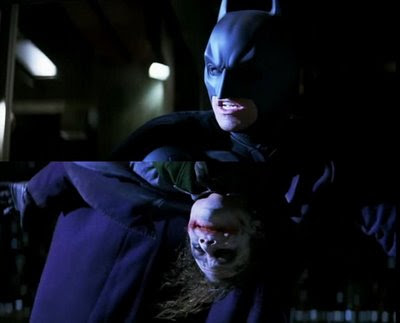
Do these two films have a weird sort of ‘franchise’ connection going on? The only reason I’m calling The Dark Knight a sequel to I’m Not There is to radically expand the possibilities of what a sequel could be like in its relationship to the original film. A more particular description would see The Dark Knight as a ‘retelling’ or a ‘reading’ of I’m Not There, or conversely a transposition of I’m Not There’s philosophical lessons and narrative structures onto the Batman mythology. Unlike a traditional sequel, with The Dark Knight the original film’s elements are simplified, rather than developed and complicated as per usual. Ultimately both films appear mutually dependent in demonstrating that there is no ‘truth’ to identity, that instead there are only constructed, fragile, problematic and contradictory symbolic personae that are ultimately insufficient to describe reality and truth.
If there’s going to be a third film to make this a trilogy, it will almost certainly be Terry Gilliam’s upcoming The Imaginarium of Doctor Parnassus. The Dark Knight was more fantastical than I’m Not There, and this film, to be released at the end of this year, promises to be even more fantastical again (and self-aware too), to complete the pattern. It’ll star Heath Ledger once more as a mysterious outsider who wears a mask and transforms into different legendary actors (due to Ledger’s death during filming), and Tom Waits (a singer-songwriter relatively akin to Dylan) will play the Devil (the Joker’s analogue). The parallels with I’m Not There and The Dark Knight look set to be shockingly uncanny, and I’ll be watching it with those films in mind (just for fun, though – I’ll be leaving my tinfoil hat at home). If the ‘trilogy’ were to have an overall name, it could well be ‘Will The Real Heath Ledger Please Stand Up?’.
Why an overtly Hollywood sequel to such an overtly un-Hollywood film? Well, what better arena to demonstrate and deconstruct the world of symbolic personae and legend narratives? And naturally the hugely successful Hollywood sequel was hinted at in I’m Not There. The young ‘Woody Guthrie’, having cheerfully performed one of his songs to the middle-class white family who are sheltering him, makes an ironically idealistic promise: ‘I’ve been writing me some songs, songs about what’s going on, and I’m gonna take these songs and I’m gonna head straight to Hollywood and make it big, just like Elvis Presley’. The response is, ‘Well Woody I wouldn’t be surprised if you did just that’.
I was recently fortunate to have had my discussion of the book Fear of Music linked to from the Twitter accounts of jlacan and (someone who is supposed to be) Slavoj Žižek (zizekspeaks). If any Lacan or Žižek readers are still browsing, or if anyone else is interested, they may have noticed a trace influence of both writers’ work in the above article, which had actually been in the pipeline for roughly a year. Though I’m drawing on areas such as psychoanalysis, semiotics, post-structuralism and queer theory, I’ve generally tried use the associated vocabularies and detail of those areas only minimally, so as encourage casual armchair perusal. That’s why this blog has been so strangely and ambiguously pitched so far – but I’m workin’ on it…









